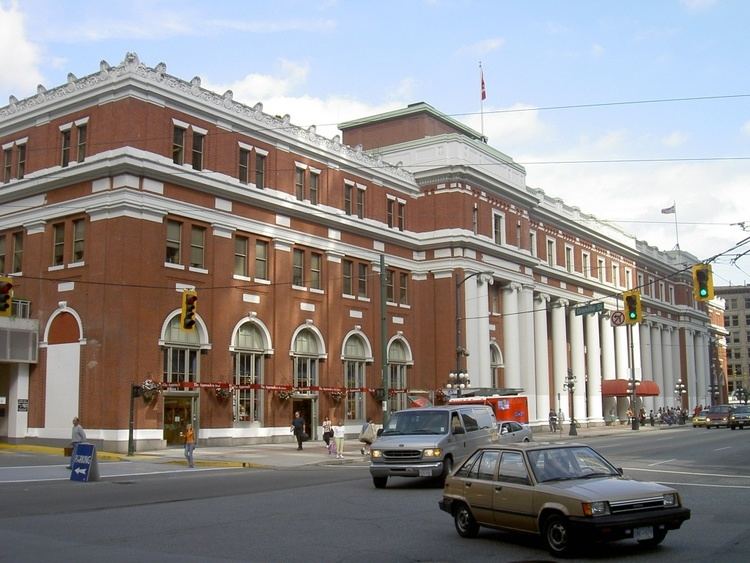Connections 95 B-Line Opened 1914 Bicycle facilities outside bike racks | Disabled access Yes Province British Columbia Tracks 6 | |
 | ||
Owned by Canadian Pacific RailwayBC TransitTransLink Platforms 3 separate sets of centre platforms Structure type At-grade and underground Address 601 W Cordova St, Vancouver, BC V6C 1G6, Canada Similar | ||
Waterfront station is a major intermodal public transportation facility and the main transit terminus in Downtown Vancouver, British Columbia, Canada.
Contents
Location
Waterfront station is located on the south shore of Burrard Inlet, just east of the north foot of Granville Street at 601 West Cordova Street. The station is within walking distance of Vancouver's historical Gastown district, the Canada Place cruise ship terminal, the Helijet International helipad, and Vancouver Harbour Water Aerodrome, the downtown float plane terminals for Harbour Air, West Coast Air, Salt Spring Air, and other airlines.
Other nearby facilities include the downtown campuses for Simon Fraser University and the British Columbia Institute of Technology, federal government services in the Sinclair Centre, the Vancouver Convention & Exhibition Centre, and the Harbour Centre office tower, revolving restaurant and observation deck. Underground passages connect passengers directly to the Fairmont Waterfront Hotel and Canada Place. There are also two other street-level entrances to the station, one on Howe Street to the west for direct access to the Expo Line (labelled as platforms 1 and 2 on the station map) and another on Granville Street to the south for direct access to the Canada Line (platforms 3 and 4).
Waterfront station was one of the first to receive TransLink's new "T" signage, denoting a transit station. This signage was installed in the downtown core of Vancouver to help visitors during the 2010 Olympics to identify a transit hub.
Services
Waterfront station is the intermodal terminus in downtown Vancouver for the following TransLink services:
On October 22, 2016, Expo Line and Millennium Line services were reconfigured in preparation for the opening of the Evergreen Extension; as a result, the Millennium Line—which had since its inception in 2002 been interlined with the Expo Line between Waterfront and Columbia Stations—ceased service at this station.
History
Waterfront station was built by the Canadian Pacific Railway (CPR) in 1914, and was the Pacific terminus for the CPR's transcontinental passenger trains to Montreal and Toronto. The current station is the third CPR station. The previous CPR station was located one block west, at the foot of Granville, and unlike the current classical-styled Waterfront station was built in "railway gothic" like the CPR's many railway hotels. In 1978, when Via Rail took over the passenger operations of the CPR and the Canadian National Railway, it continued using both railways' Vancouver stations, but a year later, Via consolidated its Vancouver operations at the CN station near False Creek (now called Pacific Central station), and ceased using the CPR station. The last scheduled Via passenger train to use Waterfront station departed on 27 Oct 1979.
Waterfront station's transformation into a public intermodal transit facility began in 1977. That year, SeaBus began operating out of a purpose-built floating pier that was connected to the main terminal building via an overhead walkway above the CPR tracks. The CPR's passenger platform and some of its tracks were torn up in the early 1980s to make way for the guideway of the original SkyTrain line (Expo Line), which opened on December 11, 1985. During Expo 86, SkyTrain operated special shuttle trains between Waterfront station and Stadium–Chinatown station (then named Stadium station), connecting the Canadian Pavilion at Canada Place to the main Expo site along False Creek.
In 1995, platforms were built adjacent to the SkyTrain station for the new West Coast Express, which uses the existing CPR tracks. (The West Coast Express platforms are in the same location as the old CPR platforms.) In 2002, Millennium Line trains began sharing the SkyTrain tracks with the Expo Line. In 2009, the Canada Line opened with a separate platform and entrance/exit point within the grand CPR station. Waterfront station serves as the common terminus point for all three SkyTrain metro lines.
A private ferry company, Royal SeaLink Express, ran passenger ferries from a new dock on the west side of the SeaBus terminal to Victoria and Nanaimo in the early 1990s, but ultimately folded. In 2003, HarbourLynx began operating out of Royal Sealink's old facility at the SeaBus terminal. In 2006, following major engine problems with their only vessel, they folded as well.
Architecture
The main station building was designed in a neoclassical style, with a symmetrical red-brick facade dominated by a row of smooth, white ionic order columns. The ionic columns are repeated in the grand interior hall, flanking the perimeter of the space. The main hall features two large clocks facing each other high on the east and west walls. Paintings depicting various scenic Canadian landscapes line the walls above the columns.
